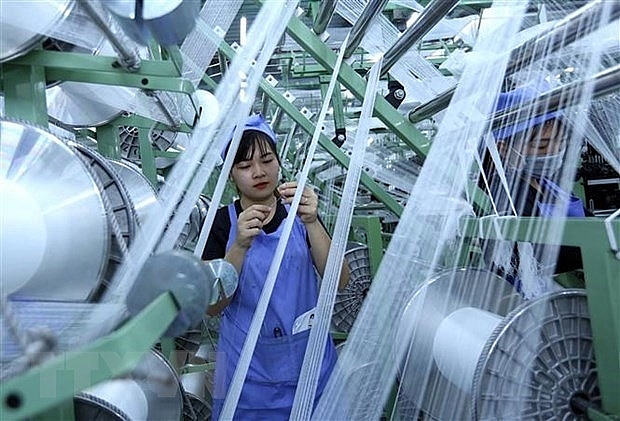ADB affirms economic growth potential of Vietnam
 |
| The knitted fabric factory of the Best Pacific Vietnam Co. Ltd, invested by Hong Kong (China), in the Vietnam-Singapore Industrial Park in Hai Duong province (Photo: VNA) |
ADB Vietnam’s chief economist Nguyen Minh Cuong affirmed in an interview granted to Vietnam News Agency that there are many reasons for ADB to believe in the growth potential of Vietnam.
He said the forecast for Vietnam was based on the growth of domestic consumption, plus strong increases in export turnover and foreign investment in the past 11 months. Total foreign trade of Vietnam could reach 500 billion USD this year or even higher.
The bank also noticed the remarkable improvement in Vietnam’s business environment over the past years, along with the trend of foreign investment shifting from China to other markets, and in the context of the US-China trade dispute, Vietnam is really an attractive market for investors.
Besides, Vietnam has made noteworthy improvement in competitiveness, which made it easy to understand why the foreign investment flow into Vietnam is rising strongly.
Another important reason is the macro-economic stability in Vietnam, with low inflation rate thanks to the State Bank’s flexible and appropriate monetary policies which well support growth.
According to the expert, though public investment disbursement may remain slow, authorized agencies have put forth some drastic measures and the pace is expected to accelerate.
Asked to comment on concerns that the reform process in Vietnam is slowing down, the ADB expert said the reform is still underway effectively, adding that he hopes for stronger measures in some aspects, for example the rearrangement of State-owned enterprises, in which the current progress has not matched expectations and targets set by the State.
In the finance-banking sector, despite some positive changes such as the settlement of bad debt or credit risk control in accordance with Basel II-stand, the reform pace is under expectation, calling for stronger measures, especially in handling bad debt.
Cuong affirmed that there are not many reasons for us to worry about Vietnam’s reform progress, explaining that besides internal factors, Vietnam’s reform is driven by many external factors.
In the 2019-2020 period, the external factors are clear, he said, citing the country’s commitments to the Comprehensive and Progressive Agreement for Trans-Pacific Partnership (CPTPP) and the Vietnam-European Union Free Trade Agreement.
Therefore, the expert was of the opinion that the driver for reform will continue to strengthen in 2020.
Talking about solutions to promote the development of the private sector, the ADB expert said the Government plays a very important role.
Accounting for more than 96 percent of the total number of enterprises nationwide, the private sector in Vietnam is very diverse, with household businesses (which make up a big portion and contributing about 30 percent of the national GDP), small- and medium-sized enterprises (SMEs) and big private groups.
Cuong noted that the past decade has seen a strong development of large-scale private groups. The question is how to enable those large-scale private groups to create big breakthroughs for the economy while ensuring the extensive and fair development of SMEs and household businesses, he said, stressing that that is the task for institutions and policies.
According to the expert, large private groups should realize that when Vietnam joins bilateral and multilateral FTAs which require the country to create a transparent and fair playground for domestic and foreign enterprises, there will be no preferential treatment or specific policies for domestic private companies. Therefore, the private sector should realize advantages and difficulties and learn how to optimize opportunities to join the global value chains.
For SMEs and household businesses, Cuong said while many used to say this sector faces difficulties and obstacles in accessing financial credit, reality and comparison with other countries in the region and the world show that regulations on collateral, feasible business plans and many other requirements of banks are similar be in any country.
He expressed his personal view that financial credit access is not the basic issue. Instead, it is the firm’s capacity to absorb capital, which depend on the firm’s administration capacity, workers’ skills, which requires attention of firms, Cuong said.
What the stars mean:
★ Poor ★ ★ Promising ★★★ Good ★★★★ Very good ★★★★★ Exceptional
 Tag:
Tag:
Related Contents
Latest News
More News
- Sustainability a core value for DKSH’s vision (January 07, 2026 | 16:00)
- People encouraged to contribute and grow at AstraZeneca Vietnam (January 07, 2026 | 15:48)
- Dat Bike accelerates sustainable mobility (January 07, 2026 | 15:24)
- Innovation to support modern healthcare development (January 07, 2026 | 10:00)
- Six localities record double-digit growth as regional performance diverges in 2025 (January 06, 2026 | 18:00)
- E-commerce market undergoes transformation amid rising competition and regulation (January 06, 2026 | 17:54)
- Vietnam’s industrial output hits seven-year high in 2025 (January 06, 2026 | 17:47)
- GELEX’s credit rating outlook upgraded to 'Positive' by VIS Rating (January 06, 2026 | 16:49)
- Finance sector lays firm groundwork for 2026 after major reform (January 06, 2026 | 15:30)
- Vietnam’s seafood exports surpass $11 billion in 2025 (January 06, 2026 | 08:51)






















 Mobile Version
Mobile Version